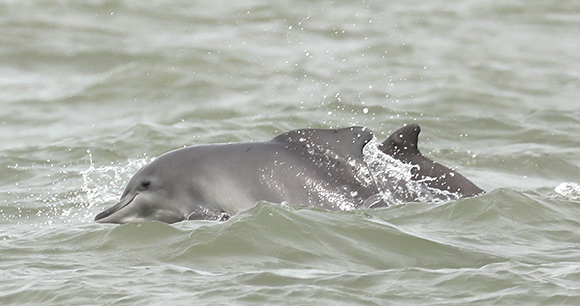
There are four species of humpback dolphins (genus Sousa) and one subspecies, all of which are considered to be decreasing in number by the International Union for Conservation of Nature (IUCN). The most imperiled is the Atlantic humpback dolphin (S. teuszii), found only in relatively shallow waters close to shore along the western African coast, ranging through at least 13 countries from Western Sahara south to Angola. The IUCN Red List currently classifies this species as Critically Endangered, signifying “an extremely high risk of extinction in the wild.”
Currently, while 3,000 Atlantic humpback dolphins may remain, they are fragmented into at least 11 populations, with the size of each population ranging from the tens to the low hundreds. This dolphin is one of the least-known species of dolphins or porpoises in the world. There are scant data, for instance, to indicate the degree—if any—of genetic or morphological differentiation among the fragmented populations, or whether animals lost to one population would be replaced by animals moving between populations. The dearth of knowledge on most aspects of the species’ biology and ecology, as well as a lack of regional capacity, represent serious obstacles to developing effective conservation measures.
Generally speaking, management protections in this region are inadequate. Although marine protected areas do exist in some range countries, the effectiveness of their management is variable, and few laws or regulations exist specifically to conserve the Atlantic humpback dolphin. As elsewhere for nearshore cetaceans, entanglement in fishing gear is a primary threat.
Depletion of the dolphins’ prey by fisheries, habitat loss related to coastal development, and anthropogenic noise are additional threats. There appears to be little commercial, recreational, or scientific use of Atlantic humpback dolphins, but a market for their meat is growing, possibly an outcome of finding the dolphins entangled in fishing nets and choosing to utilize them as food and shark bait rather than discard them. Disease and predation have been poorly studied, but large sharks and killer whales are likely the only natural predators.
In September 2021, AWI, the Center for Biological Diversity, and VIVA Vaquita petitioned the National Marine Fisheries Service (NMFS) to list the Atlantic humpback dolphin as a threatened or endangered species under the Endangered Species Act (ESA). While the species is entirely outside US territory, such a listing under US law can spotlight conservation needs globally, leverage funding, and create a mechanism for sharing expertise and resources.
In December 2021, NMFS published a 90-day finding that such a listing may be warranted. A status review was then initiated, during which NMFS consulted with experts from the region. Its final conclusions supported a listing. In April 2023, a proposed rule to list the Atlantic humpback dolphin as endangered was published. The petitioning groups filed supportive comments and encouraged scientists and constituents to do the same. A final rule was published in February 2024, listing the Atlantic humpback dolphin as endangered, a positive step forward for the most fragile of the Sousa species.
Fortunately, this species has, in recent years, been the focus of considerable regional research, spearheaded by the Consortium for the Conservation of the Atlantic Humpback Dolphin Foundation (CCAHD Foundation). According to its website,
The CCAHD Foundation acts as an umbrella organization that brings together international conservation management bodies, cetacean scientists from around the world, and organizations and individuals in the countries where the Critically Endangered Atlantic humpback dolphin is found. The CCAHD Foundation’s aim is to promote and support research and conservation actions throughout the species’ range, and provide robust conservation advice on the Atlantic humpback dolphin.
The efforts to have the species listed under the ESA were coordinated with the CCAHD Foundation, of which VIVA Vaquita, one of the ESA petitioners, is a partner.
AWI’s work to protect the Atlantic humpback dolphin is part of our ongoing focus on endangered small cetacean species—including the vaquita and the Taiwanese white dolphin (a Sousa subspecies)—all of which have been put at risk by anthropogenic activities. We hope to do our part to prevent the Atlantic humpback dolphin from declining to dangerously small numbers (as have the vaquita and Taiwanese white dolphin)—although some of its fragmented populations may already be at grave risk of extirpation. We will continue to support Atlantic humpback dolphin conservation, including through our work in the International Whaling Commission’s Scientific Committee and its Small Cetaceans Subcommittee.